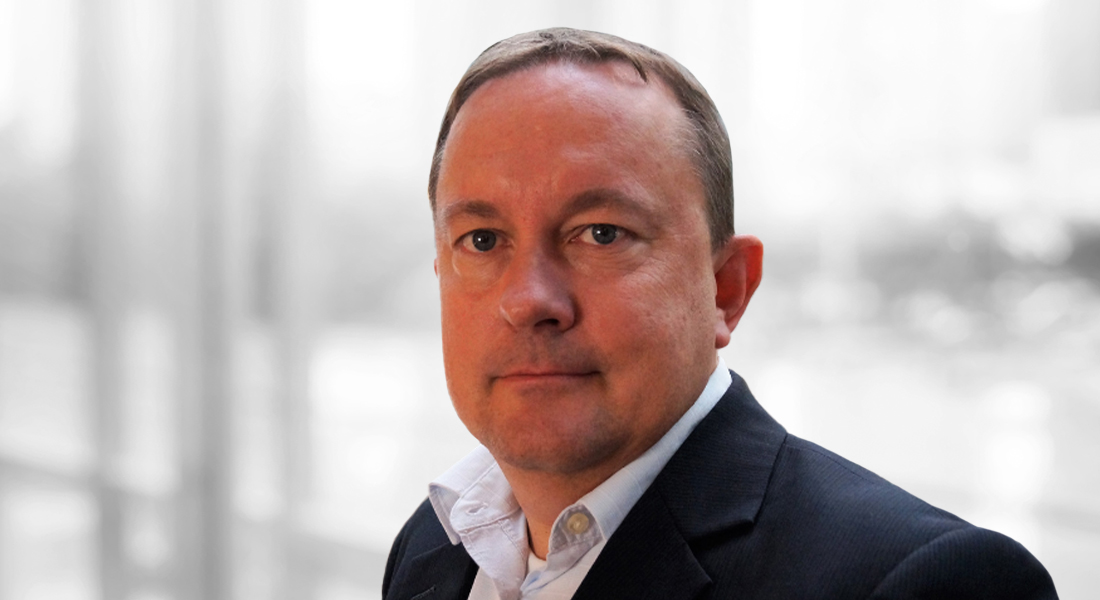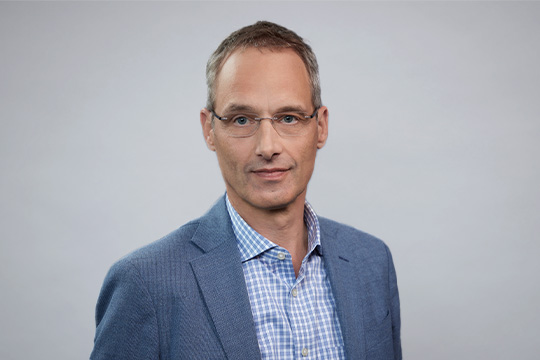Dr. Frank Höpner, professor, is the member of senior management in charge of the topics corporate development and strategy at ENGIE Germany. He is pursuing the goal of rethinking the energy industry business and the ENGIE portfolio from the perspective of customer-centric service logic. He spoke to Volker Rieger, Detecon Partner, about the digitalization of the energy industry and the differences between Germany, France, and Silicon Valley in dealing with digital transformation.
Mr. Höpner, ENGIE sometimes appears to me – if you will allow me to put it this way – as the “bird of paradise” in the energy business. In your company, you bring together the traditions of GDF Suez and Cofely. What impact does that have on your company and on the way you deal with digitalization?
Prof. Dr. Frank Höpner: Before the new name was introduced, ENGIE was called GDF Suez. GDF, the abbreviation of Gaz de France, is self-evident. And Suez are the people who built the canal of the same name. A major part of our mindset comes from this name alone. We have historically two pillars: our competence in energy and our competence in engineering. We always depended on these two mainstays for many years.
For much of this time, these two areas were viewed separately. A few years ago, we realized how valuable it is to remove the utility blinders and take a broader look at the energy business. Since then, it has been the declared strategy of the group to join these two pillars of our business and to blend their cultures, mindsets, and competences.
Could you explain that in greater detail?
Utilities think in terms of the energy markets, our engineers tend to think more about assets, and our service employees are highly customer-centric. We are now merging these different ways of seeing the world. Customers want a service provider who manages their properties – and not one that just delivers energy.
Have you noticed any changes so far?
Yes, very clear ones. On the one hand, we have the energy experts with their highly professional and conception-oriented position. And on the other hand, there are the service people who tend to take more of a “hands-on” approach and who are generally much closer to the customers. Together, we are able to “read” customers in a completely different way.
From the management standpoint, our aim is to provide a meaningful structure to our leadership of ENGIE. Following the merger, we placed all divisions of the company under joint management – without regard for the boundaries between the legal entities. Nevertheless, we still see the need to differentiate between business divisions such as “energy” or “services.” On the other hand, we are constantly on the look-out for synergies or – as is so wonderfully said – cross-selling aspects whenever possible. We are not concerned merely with installing a local heating line or a power line in the ground, but instead with holistic concepts and topics such as electromobility and carsharing, facility management, concierge services, or even delivery and logistics.
Many companies are launching huge programs intended to break up silo thinking and to promote collaboration. Do you have anything like this going on?
We have started a series of cultural programs that we hope will create a certain mindset among our employees, ultimately leading to a bottom-up approach and a successful innovation culture. Every year, for instance, we award worldwide an innovation trophy. We receive as many as 600 nominations for the trophy, and they compete in a kind of Olympic Games. Conversely, we also make sure that we generate commitment top-down at the right points. In the meantime, we have many positive examples of this. The colleagues who construct technical equipment and have superb competence in the field of measurement and control technology collaborate with the colleagues from the energy side who consider the possible uses of this equipment on the control energy markets. There was such a lack of understanding during the optimization of the first system because the approaches seemed to contradict one another. In the meantime, the colleagues proverbially tip their hats to one another and talk about completely new solutions.
How have you anchored the subject of digitalization? Is there an institution or a person, a CDO, for instance? Is this your role as a strategist, or is it bundled in a set of initiatives and programs?
We do not have any explicit bundling. One distinction is made with respect to digital topics that come from IT. We have our CIO for that. Moreover, we have development topics arising from a strategic or a long-term business perspective. They fall mostly in my purview. The CIO is in charge of all topics relating to the development of the company as a whole through the application of the IT logic. When it is a matter of other topics such as AR (augmented reality) or the use of robots, we say that is more likely to come from the application logic. IT’s task is then to integrate such topics into the IT world.
Digitalization frequently involves more than just IT and new applications. Many companies are also looking intensively at the cultural aspect of digitalization. Key words here are design thinking, agile, scrum, etc. What is the situation in your company?
We are concerned with this as well. Design thinking is a wonderful example. A few months ago, I said during a management conference that I was sponsoring a couple of design thinking workshops from business development. The response was overwhelming, and ultimately we financed more workshops than we originally intended. They gave rise to a lot of exciting ideas – often at the interfaces between the business divisions. One topic, that of “green heating and refrigeration,” that we had already put on our to-do list for strategic reasons, developed on the basis of the idea of an employee to such an extent that we ended up buying a company.
As we see it, digital is an enabler so that we can become faster and create more feasible solutions. We are not in an industry such as the bank industry, for example, where the product per se must be digital. Still, it is necessary, of course, in the sense of time to market that we apply these methods and technologies. We note here that we frequently come up with creative solutions faster on the service side than on the energy side. In this sense, the energy industry is relatively sluggish in regard to digital change in comparison with other industries.
The way you have described your methods so far make them seem very business-driven. You appear to be doing without the great digital superstructure, the huge digitalization wave that floods the entire company. Do you believe this will be enough when all is said and done?
Yes and no. On the one hand, yes; we already have some wonderful success stories. On the other hand, we are still not fast enough in all areas. When taking a pragmatic approach, there is, of course, always the question of whether I really have the right resources. I have the resources that are prepared to tackle new topics in the sense of the logic of operating business. But I don’t know whether they are really the best or fastest – nor do I know whether I would achieve a different velocity for the change in content with another organizational form such as a digital office or our own digital unit.
Do you pay less attention to radical innovation that you might use to call into question your current business? Many companies are investing a lot of money especially in such disruptive areas.
I can say very clearly: no! We do not believe in disruption in the sense that we will be engaged in a completely different business tomorrow. Since we at ENGIE come from an energy and engineering logic, we are not per se a digital company. Our core competencies are energy generation, distribution, and supply on the one hand and, on the other, everything that relates to the properties and structures of the customers – i.e., facility competence that we apply to management, planning, construction, and so on.
So we look to see what a good fit for us is, what direction our development should take, and what depth of development we can offer. Ideally, these are topics where energy and service come together. There may possibly be some niches that we can occupy. Carsharing in the context of district solutions could be an example. But we will not become a comprehensive mobility provider. There are already large providers in this sector; two of them are currently involved in a merger process. So I ask these questions: How can I earn money with it, and is it a part of my DNA?
Let us return to the cultural aspects. They often include the topic of working culture or, as a buzzword, “New Work.” What is your position on this?
We need the creativity of our people from different business divisions and various roles – the engineers as well as the pragmatists on the site. This requires us to collaborate across project boundaries. Moreover, our business is changing so that we must develop customer-specific portfolios more and more often and cannot simply sell standardized products or services. Quite often, we must derive our solution from the customer’s specifications, which may in part be only partially qualified. This is project management with a lot of unknowns. Our employees must learn to grow when performing an unfamiliar task and to achieve what is needed on a team.
Some of them take to cross-division project work very quickly; others are more strongly rooted in their current jobs. Naturally, we use open spaces and other methods to encourage people to collaborate and to grow together. For me, however, this is in a way merely the compulsories that are necessary to achieve a certain opening up. Parallel to this, we on the management team are working intensely on fostering the readiness for cross-division collaboration. We must get away from first having to clarify each and every time who will provide resources – without this impacting the P&L. Everyone must see that everything is give and take and that difficulties can sometimes be resolved without an escalation to the next level.
Management is not alone in putting up resistance to collaboration. Often enough, the employees are also hesitant to assume more responsibility, to act outside the box of their own positions, or to think in company-wide or project-wide terms.
To be quite honest, we have that problem as well. Getting people to move outside their comfort zone is an uphill battle. Of course, approaches such as design thinking are a help to us. We see that employees are more likely to be willing to work with new colleagues on a topic within a format of this type. The important factor here is their keen interest in the topic.
On the other hand, daily business cannot be neglected. Always being dedicated solely to innovation or solely to pilot projects or solely to being at the cutting edge is not what brings in the money. We strive to find the right balance in our communication.
By acting this way, you mirror precisely the methods that are the subject of discussions revolving around the key word “ambidexterity.” All established companies are facing the challenge of organizing the old and the new business, including the pertinent cultures, under a single roof in such a manner that they create value while being valued as well.
I am personally not convinced that all new ideas or business models, especially the ones currently under discussion in the energy business, are viable as stand-alone solutions. I have seen a lot of business cases with low profit margins and enormous expenditures of time and effort. Many digital solutions demand major investments in systems or programming and platforms, tools, etc., before I can even begin to use them. They do not become profitable until you have “flange-mounted” them onto an existing cash flow and brought about a transformation by doing so. If I combine traditional business – such as facility management, for instance – with a new digital approach and tell my customers about the added value from the innovation, but retain the added value or the value contribution from the legacy business, then I have a chance to develop the new business as well. It is important for us that we create the right story for the customer with every innovation and do not drive a topic forward just because it is avant-garde.
I would like to take a quick look at the energy industry as a whole. Do you have a future vision of the energy business? What will happen with the market roles, sales, grid, generation? In what direction will business models change? What will the future role of the municipal utilities be? Do you expect changes in structures, the entry of new players, or will the market landscape remain the way we know it today?
When we look back over the past two decades in the energy industry, we see that deregulation has given rise to a picture that is different from what was projected at that time. There were predictions that the municipal utilities would cease to exist – but the municipal utilities and their distribution function are still with us. The role of those who distribute the atoms or molecules will still exist in the future.
At the distribution level, at least as far as electric power is concerned, I can certainly imagine a scenario in which we say that there is an overabundance of electric power, we no longer need to pay for electricity, it is a flat-rate product or a secondary product of other added-value components, e.g., the marketing of data. Although this is at the moment a rocky road because of the topic of privacy, I believe that a lot of things are possible for all parties – customers and providers both. You can extract an infinite amount of nectar for added value and for services from use behavior and customer desires. The commodity business is located between these services and the infrastructure like a bacon rind. And this is precisely where our approach of joining services with the infrastructure and the customers’ assets is rooted. Then we can use either the topic of commodity or assets and technical infrastructure – like communicating pipelines.
If we want to be used much more intensively as a service or energy provider, however, we must move into a sustainable position between customers and their assets.
Can you give us an example?
Compare this with the internet. We are currently conducting a pilot project featuring a marketplace for renewable energies on blockchain basis. A super project! The decisive point for me, however, is that the logic is changing. Suddenly, I am no longer in a supplier relationship; I am now a platform operator who has been inserted between customers and infrastructure. This can be a more sustainable position if customers have a different understanding of themselves. Our focus during such projects is not to say that I am using blockchain as a digital technology, but to ask what is the business logic behind it, what is my model, and what is my position that I must develop.
We have almost reached the end of our talk. If there were a magic elixir for digitalization, what would you incorporate into ENGIE in addition?
In many respects, we are still lacking much more sophisticated digital competence that understands itself strictly from the digital perspective. This includes data scientists, for example. If we think back to what I said before – that we can do a lot more with our customers’ data – then we need analytical skills. We must understand how we can draw much more information from market intelligence and build on it to create completely different services.
How do you decide whether and when you use the elixir?
I demand of myself that we continuously think about what is happening and make adjustments whenever necessary. As I see it at the moment, we should take the step in the direction of data scientists without relying on concrete projects. One example I use as orientation is Viessmann. It was a very strong statement when Max Viessmann was named CDO with the specific task of digitalizing the heating business. At that moment, you might have asked yourself the question: Is the heating business capable of being digitalized at all, or does it offer a basis for digital business models? This announcement led me to the recognition that it is in any case rewarding for us as well to think about this even for our boring industrial sector.
How did you proceed?
We put the topic of BIM (building information management), for example, on our to-do list. The digitalization of planning is moving in a direction that is actually a threat to our engineering human capital. If purchasing, ordering, and submission of quotations are done completely automatically on the basis of digital planning – why does anyone need our know-how? And even if it is needed, does it still generate so much added value over the advantage of digital process planning? These are the questions we have to consider critically.
What conclusions have you reached?
First of all, we examined the topic closely. On the one hand, to understand how it works and where we can continue to offer added value. We try to identify breakpoints so that not everything can be reeled off by the press of a button. While something is built by running the automatic processes, the errors that were already in the planning are also realized. On the other hand, we use BIM as a foundation for our complete digital planning of the aggregates. In the meantime, we can use AR goggles to see 3-D images of how our refrigeration machines run. And our engineers can see how they can improve the process technology or production technology even further. At the moment, this is still something of a secondary product, but later we will have the issue of how I can make a customer journey out of this. So we acknowledge the new currents in the industry and consider for ourselves what the presumed risks are, but also see the opportunities that are a part of the trends.
Professor Höpner, thank you for this highly interesting discussion!







